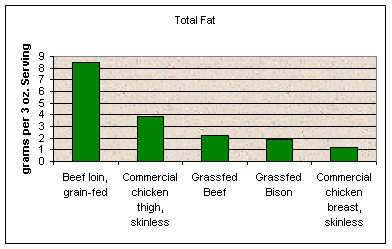How Missouri Beef is Your Best Health Food
Now there has been some discussion about the heart-healthy aspects of Missouri grass-fed beef – an all-natural health food. Here's a pretty well-documented summary from Eat Wild (http://www.eatwild.com/healthbenefits.htm):Summary of Important Health Benefits of Grassfed Meats, Eggs and Dairy
Lower in Fat and Calories. There are a number of
nutritional differences between the meat of pasture-raised and
feedlot-raised animals. To begin with, meat from grass-fed cattle,
sheep, and bison is lower in total fat. If the meat is very lean, it can
have one third as much fat as a similar cut from a grain-fed animal. In
fact, as you can see by the graph below, grass-fed beef can have the
same amount of fat as skinless chicken breast, wild deer, or elk.[1] Research shows that lean beef actually lowers your "bad" LDL cholesterol levels.[2]
Data from J. Animal Sci 80(5):1202-11.
Because meat from grass-fed animals is
lower in fat than meat from grain-fed animals, it is also lower in
calories. (Fat has 9 calories per gram, compared with only 4 calories
for protein and carbohydrates. The greater the fat content, the greater
the number of calories.) As an example, a 6-ounce steak from a
grass-finished steer can have 100 fewer calories than a 6-ounce steak
from a grain-fed steer. If you eat a typical amount of beef (66.5 pounds
a year), switching to lean grassfed beef will save you 17,733 calories a
year—without requiring any willpower or change in your eating habits.
If everything else in your diet remains constant, you'll lose about six
pounds a year. If all Americans switched to grassfed meat, our national
epidemic of obesity might diminish.
In the past few years, producers of
grass-fed beef have been looking for ways to increase the amount of
marbling in the meat so that consumers will have a more familiar
product. But even these fatter cuts of grass-fed beef are lower in fat
and calories than beef from grain-fed cattle.
But that's another discussion for another time.
Come, do a working vacation out at our farm and walk a couple miles with me every day in heavy boots and humid weather - that will start melting the pounds off...
References:
1. Rule, D. C., K. S. Brought on, S. M. Shellito, and G. Maiorano. "Comparison of Muscle Fatty Acid Profiles and Cholesterol Concentrations of Bison, Beef Cattle, Elk, and Chicken." J Anim Sci 80, no. 5 (2002): 1202-11.
2. Davidson, M. H., D. Hunninghake, et al. (1999). "Comparison of the effects of lean red meat vs lean white meat on serum lipid levels among free-living persons with hypercholesterolemia: a long-term, randomized clinical trial." Arch Intern Med 159(12): 1331-8. The conclusion of this study: "... diets containing primarily lean red meat or lean white meat produced similar reductions in LDL cholesterol and elevations in HDL cholesterol, which were maintained throughout the 36 weeks of treatment."

